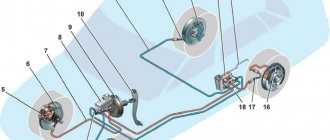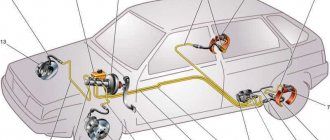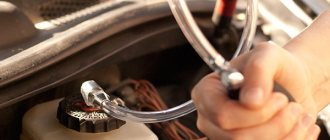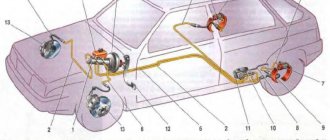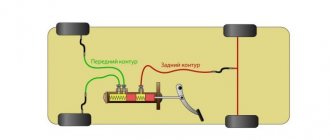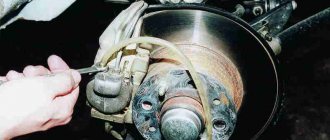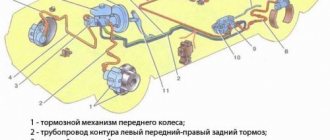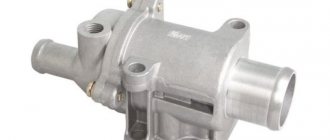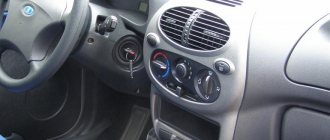According to information provided by the manufacturer of the Lada Vesta, any configuration comes with an ABS+BAS braking system. Moreover, the type of brake pads on the front wheels will be different from those installed on the rear wheels. This is due to the lower cost of the mechanisms that were used on previously created cars of this brand. On the front wheels, the braking system of the Lada Vesta will be a disc mechanism, and on the rear wheels it will be a drum mechanism. In addition to the anti-lock braking system with emergency brake assist (ABS+BAS), all trim levels (Classic, Comfort, Luxury) will be equipped with the following modules:
- Electronic brake force distribution (EBD);
- Hill Start Assist (HSA);
- Exchange rate stability system (ESC);
- Traction control system (TCS).
↑ Features and characteristics of the Lada Vesta brake system
The first glance at the drum brakes of the Lada Vesta causes slight bewilderment: after removing the wheel, the owner will not find any protruding parts or mechanisms. The secret of Vesta is hidden not in nanotechnology, but under the central cap: once you pry it off with a wide flat chisel, the large nut securing the drum will open. It would seem that it is enough to use a 30mm socket, unscrew the fasteners, and that’s it. But that was not the case - you need to perform the following steps:
- Release the parking brake (“handbrake”).
- Using a thin flat tool (screwdriver), rotate the ratchet mechanism to bring the pads together.
- And only after this can you begin to dismantle the drum.
Important. In comparison with other models, the same Granta, the design of the brake system of the rear wheels of the Lada Vesta has undergone significant changes; it will not be possible to apply the previous methods of maintenance and repair to it.
The mechanism has become both simpler and more complex at the same time: in order to “get” onto the ratchet, you will need to insert the slot of a screwdriver into one of 4 holes. But you won’t have to worry about adjusting the parking brake: the adjustment will be done automatically. Experts note that the brake cylinder has become stronger, more solid, and the system itself has become more reliable; a self-regulation function has been added to it.
Cheap and spacious inside
The door opened easily, with half a touch of the handle, and slammed just as pleasantly and easily. The front passenger seat is spacious for my height (181 cm) - my knees don’t rest anywhere, the belt is height-adjustable and doesn’t rub my collarbone. There are three-stage heated seats and cup holders. The cup holders are shallow and inconvenient to use: on strong bumps, hot coffee can fly out and scald your knee.
The interior was not surprising. A lot of cheap, “mismatched” plastic, some “childish” multi-colored inserts on the panel and door cards, an instrument panel with orange scales “a la sport”, which distract from the digital values. The location of the buttons, the convenience and range of adjustment of the seat and steering wheel do not raise any questions. By the way, even the lumbar support is adjustable here, which is rare for this class.
The rear seats are comfortable. There is a decent margin in front of the knees, as well as above the head. The seats are molded for two, but since there is a middle headrest, three can ride, the amount of space in the waist and shoulders allows this. But it’s still more convenient for two. The couple is provided with heated seats and a center armrest with cup holders. There are also USB and 12-volt charging ports to choose from.
The trunk caused admiration - there is no other way to say it. It’s not like in the “economy”, in the C-class I don’t remember anyone having such a carefully thought-out luggage compartment. Volume - 480 liters, regular rectangular shape. On the right is a closed niche for small items. On the left are several compartments for small items and a mesh. There are a bunch of hooks, a 12-volt socket, two niches in the raised floor and a sliding shelf. Low bow to the engineers!
↑ Rear brake design
The principle of operation of the rear wheel braking system of the Lada Vesta has changed little: when you press the brake pedal, the working fluid in the hydraulic line (brake fluid) flows to special cylinders, forcing the piston to move. As a result of this, special pads diverge, pressing against the surface of a disk or drum rotating with the wheel, and the Lada Vesta car stops. As you know, starting with Granta, AvtoVAZ began installing an abs sensor, it remained on later models, only its mounting changed. The brake cylinder body has acquired stiffening ribs, making it stronger and, therefore, more reliable.
Compared to previous generations, the rear brakes on the Lada Vesta lost a tachometer disc, which was often damaged during removal or replacement of pads. It is easy to select the required spare parts, including a brake disc or cylinder, using the Lada Vesta catalog numbers. It should be remembered that not all parts from other models are compatible with West ones.
Components
In such a situation, there are 2 scenarios:
- Carry out modifications in accordance with the factory diagram;
- Purchase components from another manufacturer.
IMPORTANT! Unauthorized modifications to the design of the car's braking system, which includes the independent installation of rear disc brakes on the Lada Vesta, can be regarded as a violation of traffic rules. And so, one of the owners of the Lada Vesta in the Exclusive configuration said that he was able to find out from an AvtoVAZ employee exactly what components were needed to replace drum brakes with disc brakes
And so, one of the owners of the Lada Vesta in the Exclusive configuration said that he was able to find out from an AvtoVAZ employee exactly what components were needed to replace drum brakes with disc brakes.
According to an employee of the plant, there is no need to replace the beam or reflash the ABS block, and this significantly speeds up and reduces the cost of the work.
In addition, the picture clearly shows that there is a standard spacer between the axle and the beam and it is to this spacer that the boot is fixed. From the factory, the hub and disc come separately, so after installing the rear disc brakes on the Lada Vesta yourself, there is no need to replace the bearings if you need to replace the disc.
All the components necessary to replace the brakes with your own hands are presented in the table along with the article numbers.
| Position | vendor code |
| Right brake hose mounting bracket | 8450031136 |
| Left brake hose mounting bracket | 8450031137 |
| Rear brake flexible hose assembly – 2 pcs. | 8450031129 |
| Rear brake pads (full set) | 11196-3502089-00 |
| Washer 10 | 00001-000516870 |
| Ball joint fixing bolt | 21080-2904194-00 |
| Washer 10 | 00001-000516870 |
| Ball joint fixing bolt | 21080-2904194-00 |
| Rear left brake (assembly) | 8450031163 |
| Rear right brake (assembly) | 8450031162 |
| Retainer fixing screw | 21080610526810 |
| Rear brake disc | 8450031131 |
| Rear wheel hub (assembly) | 8450031130 |
| Hex Head Screw | 00001-003836021 |
| Right rear brake guard | 8450031686 |
| Left rear brake guard | 8450031687 |
| Bolt M10-1.25-40 | 8450031161 |
| Left rear brake mount | 8450031132 |
| Right rear brake mount | 8450031133 |
The estimated cost of the entire kit for self-installation of rear disc brakes on a Lada Vesta is about 30,000 rubles.
↑ Cost of disc brakes and work to replace them
Despite AvtoVAZ’s agreed decision to install disc brakes on the Lada Vesta at the front and drum brakes at the rear, there are cases when this design is not a priority. These are the following options:
- This refers to the sports modification of the Lada Vesta sedan;
- this is not a production model, but a concept car;
- the standard car was modified to compete in the World Touring Car Championship (WTCC).
In all of these cases, disc brakes will be installed on the Lada Vesta, and this modification will be completely legal.
Important. Replacing standard drum brakes with disc brakes for a regular car, if it is not planned to be used in high-speed races or championships, is unlikely to be a good alternative to the factory equipment. The drum braking system is considered more reliable in urban conditions, since it is almost impervious to weather conditions. Moreover, disk systems are less protected from pebbles, dirt, and slush flying from under the wheels, which adversely affects their performance.
On average, both types of brakes - disc, drum, regardless of their placement, rear or front brakes for the Lada Vesta are equivalent in their effectiveness. Professionals will be able to appreciate the difference, and only at speeds of 120 km/h and above. If you really want to, you can still upgrade, but it will not be cheap, especially since the modernization will have to be legalized.
Reviews
| № | Positive |
| 1. | Gennady (otzovik.com): mileage 80,000 km, brake circuit is working, replaced the front pads once. |
| 2. | Vladimir (www.zr.ru): the brakes in the Lada Vesta are effective, they work quickly, there are no comments. |
| 3. | Sergey (autobann.su): the car is two years old, no capital investments. I carry out technical inspections in a timely manner and buy original consumables. |
| 4. | Vladimir (lada-vesta.net): there are no special comments on the TD, the quality is good, but when sand gets into the caliper, a metallic creak and grinding sound is heard. The spacer plate and pads are covered in rust. |
| 5. | Dmitry (otzovik.com): review of the car is positive. I've been using Lada Vesta for two years and have no particular complaints. |
| 6. | Semyon (www.zr.ru): I noticed that in the rain the effectiveness of the brakes decreases, the pedal increases free play. |
| 7. | Maxim (autobann.su): before the Lada Vesta there was a Granta, the quality of the latter is not the best. Well done engineers, they finalized the model properly. |
| 8. | Georgy (lada-vesta.net): actual mileage is 74,000 km, the condition of the hub mechanism and steering knuckle is good, production is minimal. TC and TD are worn out by 60%, reserve is at least 15%. |
| 9. | Stepan (otzovik.com): I am pleased with the quality of workmanship and assembly of the car. There were no major breakdowns; minor ones were fixed on my own. |
| 10. | Vladimir (www.zr.ru): comrades recommended installing brake system elements from Renault Megane, they say the quality is better there. Not ready for large-scale spending yet. |
| 11. | Alexander (autobann.su): the car is two years old, standard equipment, no comments, the interior is quiet, the suspension is strong. |
| 12. | Mikhalych (https://forumvesta.ru): I’m proud of my domestic car; in three years of active use it has never let me down. Good brakes are a guarantee of safety on the road. |
| Negative | |
| 13. | Konstantin (www.zr.ru): as soon as it rains, the discs immediately creak, no matter what I did, it didn’t help. The dealer refuses to replace it due to a non-warranty issue. |
| 14. | Vitaly (otzovik.com): after purchasing the Lada Vesta, I immediately replaced the original TCs and TDs with imported ones. The quality of domestic spare parts leaves much to be desired. |
| 15. | Grigory (autobann.su): the rear drums turned out to be defective, replaced under warranty from an official dealer. |
| 16. | Kirill (lada-vesta.net): if possible, replace original disks and drums with imported ones. The service life of Russian ones is short. |
↑ Signs of brake pad wear
Since the Lada Vesta has become more advanced during the design process, its braking system includes automatic adjustment of the handbrake, which will be effective regardless of the gearbox used - manual or automatic; pronounced signs of pad wear practically do not show themselves. In some cases, the car may experience uneven braking and a slow response to the brake pedal, but this does not necessarily indicate wear on the linings.
More often it is enough to timely replace the brake fluid for the Lada Vesta model and adjust the system. For the Lada, a frequency of 15 thousand kilometers for inspection is established, and it is recommended to change the pads every 60 thousand.
According to information from service specialists, on average, the linings on a Lada car will last 30-45 thousand. Compared to one of the first VAZ 2105s, this is quite a lot.
The best manufacturers, brands, analogues
The working brake system in a car is for the safety of the driver, passengers, and other road users. The basis of the design is:
During systematic use, parts wear out, linings wear out, and braking efficiency decreases. The process of preventing the brake circuit is simple, but requires attentiveness on the part of the technician.
↑ Subtleties of replacing drum brake system pads
Sooner or later, the linings on the rear brake drums of the Lada Vesta will have to be changed. To do this, you will need to find out what type of rear brakes are installed on a particular Lada Vesta sw or sedan. Just as brake pads differ in size from different models, for example, on the Vesta station wagon and Kalina 2, there are no universal solutions for disc and drum systems. It is imperative to determine the catalog number of spare parts for the car, even if a friend with Ford claims that they installed brake pads from Priora at the service center and everything fit perfectly.
In Vesta, the braking system, regardless of the suspension and type of transmission, is clearly divided into front (disc) and rear (drum) drives. To get to the pads, you will first have to remove the wheel by unscrewing 4 nuts. It should be immediately clarified that the Grant brake linings, despite their similarity to the “native” West ones, still will not fit.
In the center of the drum there is a cover under which the fastening nut is hidden. Before dismantling, it is recommended to bring the linings together using a thin screwdriver, rotating the ratchet mechanism, and also release the parking brake. After unscrewing the nut and removing the drum, the rear brake cylinder of the Lada Vesta and, in fact, the system itself will be revealed.
Important. An unconditional reason for replacing brake pads on Largus and any other car is the detection of oiling of the contact surfaces, deep grooves (cracks or chips), and peeling along the body. In this case, the entire set is changed, that is, 4 linings (2 on each wheel), and not individual ones.
Basic faults
If we exclude the possible defective parts and poor quality from the manufacturer, then the main reason why the front pads on the Lada Vesta become unusable is wear. They actively interact with other parts of the brake mechanism, and therefore a look at the nature of damage to the friction linings will make it clear what is wrong with the operation of the brake system. By correcting this error, you will increase the service life of not only the pads, but also the entire mechanism.
The nature of the malfunctions can be noted:
- Uniform wear - it manifests itself in the fact that the friction layer is worn evenly, this shows that the brakes are working well.
- Severe wear of the friction layer, brake rivets are visible - this means that you have been using the “outdated” parts for too long. The rivets could damage the disc, so it would be a good idea to inspect it for damage.
- The friction layer is worn evenly around the entire circle, but one of the sides is worn out more than the other - one of the parts of the brake system (guide or piston) does not distribute the braking force correctly. Cleaning all “live” parts and applying a new layer of lubricant will help. Naturally, everything will have to change.
- Both components are worn unevenly, the surface is strewn with irregularities and roughness. The reason for this outcome is a malfunction of the caliper guide pins - they swing and do not give an even trajectory of movement. You will have to clean them, then reapply lubricant.
- The friction lining is cracked - in this case, the “trouble” is caused by the brake discs themselves - they wear unevenly. Everything will have to change.
- Uneven wear of the friction layer means that the parts were installed incorrectly. They will have to be changed.
After performing a visual inspection of the damage, you can independently make a verdict about the breakdown. And besides this, there are several other signs by which you can find out about a faulty front pad while sitting behind the wheel.
Creak
If a squeaking noise occurs from the front when braking, this means that the pad and disc are not mating. This happens when a cheap analogue was purchased to replace the original component. But not everything is so bad - sometimes this analogue can last a long time, but the real reason is dirt that has gotten into the moving parts and reduces the contact area of the moving parts.
Vibration at speed: what is it?
Vibration at speed appears when the pads do not fit the discs - there is some incompatibility that does not manifest itself in the operation of the “original” parts. If, when braking, you still get “full contact” of these parts of the brake mechanism, this means that the wear of the hub discs themselves is haunting, and they will have to be replaced.
Conclusion
Manufacturers have made many new technical changes to the Lada Vesta sedan, which have become a huge step towards progress for the Russian automobile industry. All car components are made at the European level. Rear and front braking systems, as well as other auxiliary technologies used in Lada Vesta, are made of the highest quality, at the level of the best imported cars. Driving a new Russian car is more comfortable and safe than all previous models from AvtoVAZ.
